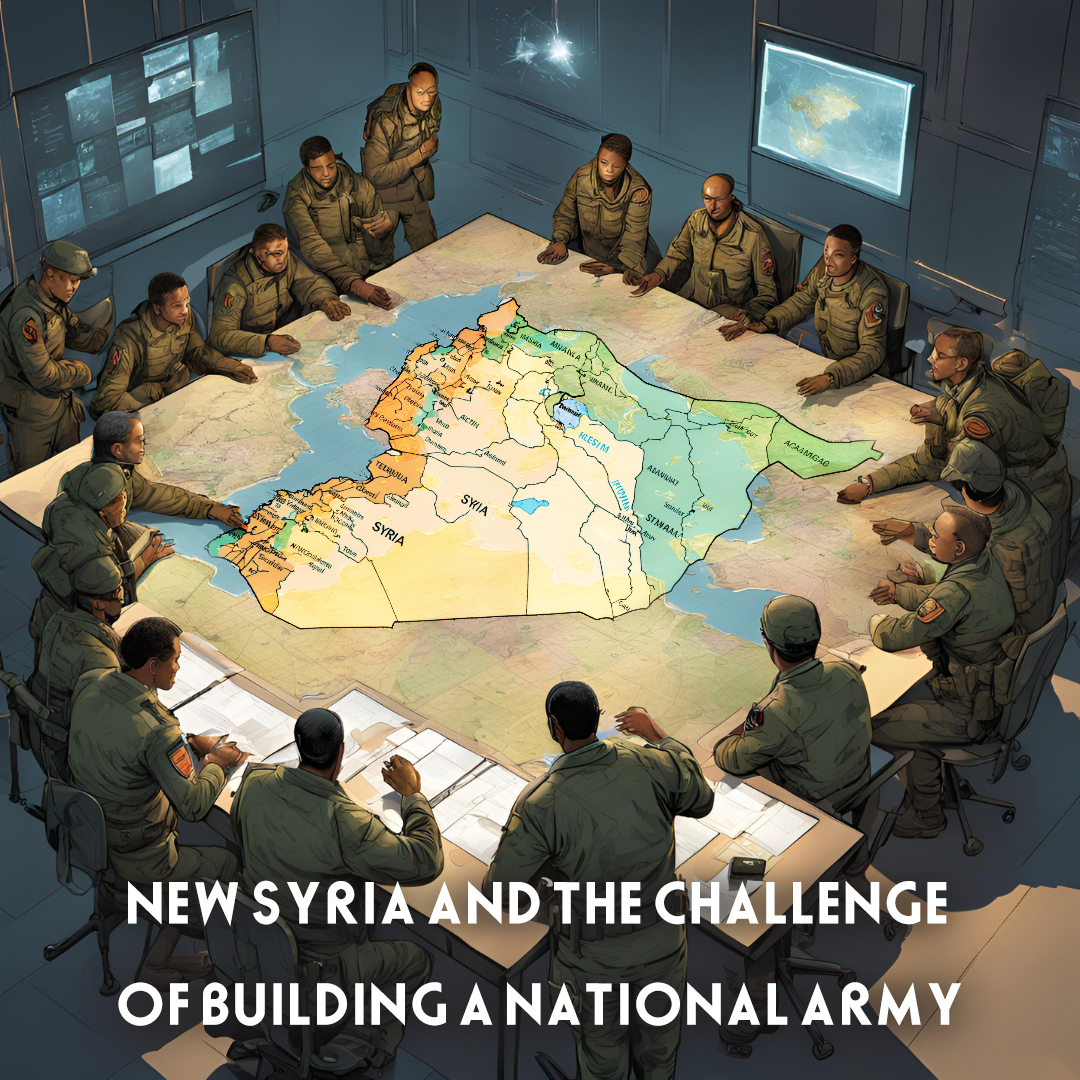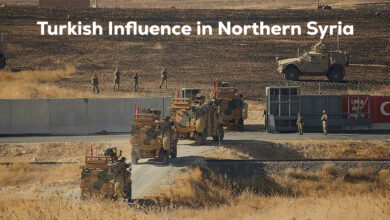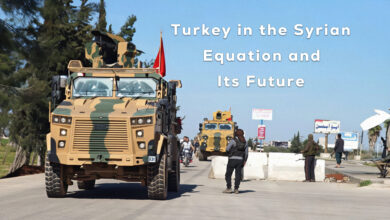New Syria and the challenge of building a national army

The political history of the Syrian state indicates that it has never experienced the existence of a national army representing Syrian societies. The army, that existed, was always in the service of the ruling class; the military institution played a significant role in shaping authoritarian rule in this state through military coups since its structure cleared up in 1920. This army has never transformed into a national army representing all Syrian communities, and history has recorded no instance confirming its fundamental mission of defending the Syrian people without discrimination and protecting their rights and dignity against aggressors, whether from within or outside. The extreme nationalist ideology of specific political factions has driven most of the wars fought in Palestine, Jordan, Lebanon, Kuwait, Iraq, and within Syria itself, where many resources and human energies were exhausted. Its dramatic collapse on December 8, 2024, points to this reality. This has intensified doubts about the national character of the Syrian army’s military doctrine since its establishment by foreign countries (Britain, France, the Soviet Union, and Russia) in support of nationalist, fascist regimes allied with it. Most of the battles it was involved in were to serve partisan and factional agendas that do not represent the will of the entire Syrian people.
On the morning of December 8, 2024, Syrians and the world awoke to the news of the collapse of the Ba’athist regime after nearly 60 years of rule over the country with an extreme nationalist and authoritarian policy. What remained of the regular army announced its surrender after a series of failures and the collapse of the military command structure in the face of the advance of the factions of “Operation Deterring Aggression,” led by “Hay’at Tahrir al-Sham (HTS).” This was followed by the Israeli forces launching airstrikes under the name “Arrow of Bashan,” which destroyed about 80% of the Syrian army’s capabilities—land, air, and naval—along with military infrastructure. This operation was described as “the largest air operation in Israel’s history,” justified by Israeli leaders as a means to prevent those capabilities from falling into the hands of extremist groups and to ensure the security of the State of Israel, following the withdrawal of Iranian forces and their militias from Syria, and Russia’s announcement of a gradual withdrawal of its troops. The military scene in Syria has become characterized by a collapsed army and various military factions with different loyalties spread across the north, south, and west of the country, in addition to the Syrian Democratic Forces (SDF) in the north and east, meaning that the current Syria no longer possesses a regular army.
Recently, there have been many discussions and a variety of opinions regarding the reconstruction of the Syrian army, the nature of the new military doctrine for the country, and the shape of the upcoming military leadership. This comes amid questions about the future of the state after it has returned to square one, meaning a regression of the political and military situation in the country to the year 1920. Despite some reassurances from the new authority in Damascus, which appeared positive on the surface, that authority cannot build trust with the diverse communities across the geography described as Syrian, which have suffered from the authority of the military establishment since the declaration of Syrian independence in 1946. This establishment has been a means to tear apart the national identity of local communities, has failed to protect the security and stability of the country, and has turned the army into a tool of intimidation and repression against anyone who opposed its authority. Consequently, the army has caused the division currently witnessed in the country and failed a moral and national test after the outbreak of the Syrian crisis in 2011, unlike the Egyptian and Tunisian armies. Therefore, most opinions generally agree that establishing a national Syrian army poses a significant challenge for any new authority in Damascus, amidst regional and international conflicts and the local communities’ rejection of replicating a new authoritarian regime.
To understand the challenges facing the process of building a national Syrian army that represents the will of all communities within the political borders of the Syrian state, it is useful to present some data related to the Syrian military, chronologically since its liberation from Ottoman occupation:
- The first Syrian army was hastily formed after the liberation of Syria from Ottoman occupation and the declaration of the Syrian Arab Kingdom on March 8, 1920. Yusuf al-Azmeh was appointed Minister of War, and it was a copy of the Arab detachments led by Prince Faisal and formed by Britain during World War I. It was a small army in the process of establishment that failed to confront the French army led by General Gouraud on July 25, 1920, despite the valor of its commander, Yusuf al-Azmeh. It was dismantled after the French occupation of Syria and the fall of the Syrian Arab Kingdom, following the withdrawal of British troops from Syria under the outcomes of the “San Remo” conference held by the Supreme Council of the Allies in Italy in April 1920, after their victory in World War I, during which Syria and Lebanon were granted to France, making the French army the only presence in Syria.
- France established its own Syrian army, equipped and trained by the French, and later opened the “Military Academy in Homs” in 1932, which formed the nucleus of the Syrian army that emerged after independence. On November 12, 1945, President Shukri al-Quwatli and Prime Minister and Minister of Defense Saadallah al-Jabri issued a decree to establish an independent Syrian national army free from France, retaining its organizational structure and French armament, based on France’s decision in 1936 to approve Syria’s independence during a transitional phase. Its first external battles were through its involvement in the Arab Rescue Army in 1948, opposing the declaration of the establishment of the state of Israel in Palestine, but it failed in its mission while northern Syrian territories remained under Turkish occupation.
- Since 1949, the army intervened in politics and worked to impose its authority through military coups driven by the agendas of the countries competing for the resources of the Middle East. During this period, the Tapline oil agreement (American) emerged, and the first coup was carried out by Hosni al-Zaim on March 30, 1949, under the pretext of the failure of the Syrian government at the time to prevent the establishment of the state of Israel; however, he signed the armistice agreement with Israel under the armistice resolution imposed by the UN Security Council in November 1948. Subsequently, a series of military coups occurred, accompanied by acts of violence and revenge among officers, while the people were largely marginalized and suffered from deteriorating political and economic conditions. These coups included:
– The coup by officer Sami al-Hinnawi, who was close to Britain in 1949, supported by the People’s Party.
– Adeeb al-Shishakli carried two coups; the first in 1949 against al-Hinnawi, which was also supported by the anti-British current in the People’s Party, but he did not directly control power. The second was a coup in 1951, in which Shishakli formed the “Arabic Liberation Movement”[1] and seized power, which lasted until 1954 when Adeeb al-Shishakli resigned and left power and the country after a series of political upheavals.
– The soft coup of the Ba’athists and nationalists in 1957, which subjected the Syrian state and its army to Egyptian authority under Gamal Abdel Nasser, following the nationalists’ rejection of the Baghdad Pact and the partisan ideological motivations for supporting Nasser’s government in the Suez War (the tripartite aggression in their party literature) in 1956 and its rapprochement with the Soviet Union; Syria was drawn into the socialist camp without a national government representing all Syrians from that time.
– The coup by Colonel Abdel Karim al-Nahlawi against the Egyptian command and the announcement of Syria’s separation from Egypt in 1961.
– On March 8, 1963, nationalist and Ba’athist officers, led by Ziyad al-Hariri and aided by the strong Ba’athist officer Salah Jadid, overthrew the separation government, and the Ba’athists seized power, reintroducing the project for union with Egypt and Iraq.
– In 1970, Hafez al-Assad conducted a coup within the Ba’ath Party and imposed his authority over the country until December 8, 2024, with one of the justifications for the coup being the defeat of the Syrian army in the June 1967 war against Israel.
- Since 1955, the Soviet Union has been a political and military partner to nationalist extremists in Syria, providing them with modern weapons, equipment, training, and building military infrastructure. The Russian Federation continued on the same path; after its direct intervention in the Syrian crisis in 2015, it attempted to reform the Syrian army to be a reliable partner that would ensure Russian interests in controlling the country, but it failed to achieve this due to military competition with Iran for influence in Syria and Moscow’s attempts to build a new army not based on national reconciliation in Syria, especially after what was known as the Syrian army abandoned its moral duty to protect the people and the country, with many of its leaders involved in committing massacres against civilians and drug trafficking. That is, the Russian leadership did not address the root problem in the Syrian army, and the difficulty of the task for Moscow was compounded by its participation with Syrian regime forces in bombing operations that also resulted in dozens of civilian casualties. Russia’s first attempts to restructure the Syrian army involved integrating the regime-affiliated militias by forming the Fourth Corps in 2015, then the Fifth Corps in 2016, and finally the Sixth Corps in 2018, placing them under its central command.
- In September 2011, media outlets circulated the issuance of a jihad ruling by the Supreme Leader of the Islamic Revolution, Ali Khamenei, in favor of the “Asad regime.” Since that date, the influx of Iranian forces and affiliated factions to Syria increased to fight alongside the Baathist regime. In August 2018, Tehran and Damascus signed a military cooperation agreement[2] under which Iran obtained exclusive privileges to assist in rebuilding the military industry and infrastructure in Syria. This negatively affected Russia’s plans regarding the Syrian army and faced discontent from regional players such as Israel, Saudi Arabia, and Jordan[3]; since that date, the Syrian army began to be directly divided between Iran and Russia.
- Under the Baathist regime, the Syrian army participated in many internal and external battles; it took part in the “Arab Rescue Army” to fight the Israeli state in 1948. In 1961, units of the Syrian army were sent to Southern Kurdistan to assist the Iraqi regime at the time in suppressing the Kurdish September Revolution. In 1970, it supported Palestinian factions during the events of “Black September” in Jordan by backing the Palestine Liberation Organization, which aimed to overthrow the Hashemite rule. In 1973, it participated alongside the Egyptian army in the October War against Israel, and in early 1976 it took part in the Lebanese civil war under the pretext of expelling Israeli forces from Lebanon, remaining there until April 2005 after being accused of assassinating Rafik Hariri (then Prime Minister of Lebanon). It was also sent to suppress the uprising of the Muslim Brotherhood in 1982, and in early 1991, Syrian army forces participated in the Gulf War (Operation Desert Storm) alongside Western forces.
- In 2011, defections began within the Syrian army; the defectors later formed the “Free Syrian Army,” which fragmented, after a year of its establishment, into dozens of factions that carried its name, leading to intense battles between the two sides from 2012 until the fall of the Baath regime.
- On December 11, 2024, “HTS” began working on restructuring the Syrian Ministry of Defense under its control, calling for all factions to merge into this ministry[4] and inviting defectors from the Baath regime forces to return. It issued a “non-guaranteed” amnesty for those conscripted into the collapsed army and appointed one of its cadres (Murhaf Abu Qasra) as Minister of Defense. During a press conference with the Turkish Foreign Minister in Damascus on December 22, 2024, it was announced that efforts would be made to disarm the Syrian Democratic Forces[5], although the method of implementation was not clarified. Some observers interpreted this as an attempt to recreate the Baathist experience in power.
- Role of the military institution in the Syrian national identity crisis:
The Syrian military institution has failed to balance the ambitions of the authority and its duties toward the Syrian people without discrimination among its communities. This may be attributed to the nature of the current Syrian state with its political boundaries; it was not formed as a result of a popular uprising, the existence of a single nation, or based on a real social contract. Historical sources indicate that it was created as a result of the partitioning of the two colonial powers, Britain and France, over the region after the Allies’ victory in World War I. Most of the governments that have succeeded each other in the Syrian state have failed or did not wish to achieve homogeneity among the diverse communities with their different ethnic, cultural, and political affiliations, and they did not contribute to the formation of a true Syrian national identity as much as they sought to glorify themselves and entrench fascism in their systems by idolizing the state’s nationalism and denying the realities of the indigenous peoples in the region. This stoked sensitivities among the communities, as hatred of the other is an inherent element of ideological extremism, and the rhetoric of hatred characterized by nationalism, sectarianism, and religion continues to prevail among many Syrians who have had their mentalities programmed for national and sectarian extremism through schools, media, party meetings, and the promotion of conspiracy theories to distract people from the source of their crises, which is the ruling authority. This was particularly enforced on the educated class, which is supposed to possess a degree of political awareness. The atrocities faced by the Kurds, Yazidis, Christians, Alawites, Druze, and many Arab communities at the hands of military institution officials and various factions—whether those that were affiliated with them or those that contributed to their emergence and opposition—serve as evidence for this. The situation does not appear to be heading toward a better condition amid the uncertainty the country is experiencing after the fall of the Baath regime and Turkish attempts to fill the Iranian void in Syria. The Turkish regime has announced its readiness to assist the new authority in Damascus in training the Syrian army[6] during the reconstruction phase, noting that the Turkish Islamic regime takes an adversarial or unfriendly position toward a broad segment of the Syrian people and its political currents. The Syrian Muslim Brotherhood is considered the only political entity that trusts the Turkish regime.
Thus, the current political and security trajectory that Syria is heading towards does not inspire optimism. It seems that the Syrian military establishment has transitioned from control by nationalists to control by Islamists, moving from the Russian-Iranian embrace to the Turkish one. So far, the factions that were at odds with “HTS” have not clearly announced their positions regarding the integration to form a single army; such as “Jaish al-Islam” faction founded by “Zahran Alloush,” and factions of the Muslim Brotherhood group that attempted to eliminate the Salafi factions close to the HTS, Islamic Liberation Party factions, and others. Each armed group in Syria organizes itself according to its own ideology and considers it the basis for any authority it may submit to, while the new authority in Damascus is a military one rather than a civilian authority. This indicates that the military institution will continue to rule Syria. Therefore, at this stage, described as historical, there is significant pessimism about the country’s future and fears of constructing a new authoritarian regime or the country being torn apart by occupiers; this raises significant issues in determining the most appropriate form for the new army, the characteristics necessary for its reconstruction, and its functions, especially after the sudden collapse of the Ba’athist regime and the lack of a ready or reliable national or constitutional plan to rebuild the Syrian army.
Given that it is one of the longest-standing regimes in power, the Ba’athist regime has been unable to build a sense of national belonging within the army due to Ba’athist dominance. It has not transformed into a national institution representing all communities within the Syrian state, and what reinforces this belief and makes it a given is the defection of thousands from its ranks after 2011 and the flight of many from conscription abroad, in addition to preventing Kurds from rising to high military ranks, and the army’s transformation into an institution for suppressing opponents of the Ba’athist regime.
On another note, the Syrian army has suffered from a lack of material and logistical support for recruits, based on the policy of “starvation for subjugation” and the infiltration of corruption within its ranks. This has led the majority of army factions to transform into gangs engaging in the seizure of the property of the displaced and internally displaced, which Syrians have called “ta’afeesh,” in addition to imposing tolls on passersby at military checkpoints and the spread of administrative corruption manifesting in what is colloquially referred to as “tafyish,” i.e., evading military work in exchange for bribes. This has become a means for the wealthy and those close to power to evade conscription, so military conscription and combat operations became limited to the impoverished and those with no alternative. This matter was legitimized through the decision of “financial alternatives”[7] in parallel with the increase in “reserve” recruitment campaigns, which many Syrians likened to the notorious Ottoman “sefer bellek” campaigns, coupled with delays in the years of discharge. This has pushed thousands of young men and those who suspect they are wanted by the conscription office to emigrate. The further erosion of national identity within the military institution has been amplified by the imposition of Russian and Iranian officers’ wills and agendas on the activities of the army and armed forces, the formation of armed factions that act as adjuncts to the army, granting them priority in terms of material support and making military decisions, transforming soldiers into a human shield for these factions in many locations.
These issues and others have led to a decline in morale and a weakening of the combat capabilities of the army, transforming it into an ineffective force at the strategic level and causing it to lose its prestige. This may explain the sudden collapse of the military institution of the Baathist regime with the loss of intelligence and fire support, both air and ground, provided by Russian and Iranian forces.
Ultimately, all these facts lead us to conclude that the Syrian military institution, from its inception until its moment of collapse, has suffered from a significant crisis that successive ruling regimes attempted to delay from exploding by various means, but it ultimately erupted with the collapse of the military system of the Syrian state. It seems that the repercussions will significantly affect attempts to rebuild this system, especially since current data regarding attempts by a specific party to monopolize power and impose its approach on the new military doctrine of the Syrian state are preparing the ground for the emergence of a new crisis within the official military institution being established, and thus continuing the crisis of national identity within the Syrian state.
- Components and Difficulties of Rebuilding the Syrian Army:
Most sources concerning military thought agree that it is impossible to build an army from groups that adhere to different ideologies, and an authoritarian regime cannot create a national army. The national or sectarian army it might form is unsuitable for countries inhabited by peoples with dissimilar cultures and beliefs. This requires benefiting from armies that can be described as relatively successful in both their national, technological, and organizational aspects and that honor the social contract of their countries, such as the American, British, Israeli, Vietnamese, and Swedish armies, regardless of the political ideology of their governments. In general, there are key components for establishing any regular army and determining the limits of the power it can achieve, which are: military doctrine[8], available resources, and wise leadership*.
No army can be built without a military doctrine; it is rooted in history since the emergence of the first armies and expresses the culture of the social entity that provides the army with fighters. There are many definitions of military doctrine, and each culture has its approach to its concept based on its combat doctrine or its motivation for fighting, represented by its responses to three questions: When do you fight? Why do you fight? How do you fight? Each army defines the principles of its military doctrine according to the threats faced by the social entity it represents, the nature of the conflict environment it may engage in, the available resources that ensure the army’s continuity and supply its energy, and the form of government to which it is subject. Therefore, military doctrine draws its broad outlines from the constitution, and the size of the military forces and the type of armament are determined based on internal and external threats and other factors.
Regarding the new situation in Syria, the outlined plan to rebuild the Syrian army involves merging the factions that fought against the Ba’athist regime within the Ministry of Defense established by “HTS.” This step is based on a fragile foundation; it does not rely on a national constitution or a social contract representing the will of the Syrians, and the military doctrine is unclear. Most factions align with religious and sectarian ideologies toward Arab nationalism. According to observations from media close to these factions since the fall of the Ba’athist regime, the internal propaganda discourse of most has been hostile towards: Kurds, Christians, Alawites, and democrats, while the external discourse has been hostile towards: Israel, Iran, and Russia. Many Arab countries, led by Iraq, have expressed their discomfort with the new security situation in Damascus. Parallelly, both Turkey and Israel occupy parts of northern and southern Syria. With Israel destroying what remained of the Syrian army’s military power and Turkey attempting to intervene in its formation—meaning the exclusion of Kurds, Druze, Alawites, and Christians from its ranks—the army being attempted to be created will not be better than its predecessor. Civil authorities will likely struggle to contain the military power of factional leaders. There are views indicating that the difficulty in forming a cohesive army in Syria will be a key factor in the “federalization” of the country or, at the very least, a shift towards self-administrations, especially in light of the lack of trust among various local military forces. The realities on the ground indicate that Kurds, Druze, Alawites, and Christians do not trust the jihadist factions, which in turn do not trust each other.
Currently, there are two armies within Syria: the SDF and the coalition of Islamic factions led by “HTS.” Although both share to the principle of the unity of Syrian territory, their approaches differ; the former relies on democracy and is considered a reliable ally of the international community in combating terrorism, while the latter relies on a sectarian interpretation of Sharia (which does not enjoy consensus among Muslims) and is a reliable ally of the Turkish regime, putting it at odds with several authentic components of the Syrian people. Thus, the path set for the re-establishment of the Syrian army leads to a situation where the crisis of Syrian national identity will continue and may worsen compared to before.
The second factor complicating the process of re-establishing the Syrian army is the weakness of resources and funding sources. Syria is a nearly destroyed country, especially concerning its military infrastructure, and there are no national capabilities to invest available resources. Many skilled individuals, expertise, and capital have emigrated, and the prevailing conditions do not encourage their return. Additionally, sanctions on the country are still in effect, along with potential problems that may arise if the issue of the Ba’athist regime’s foreign debts is raised. There is no doubt that the new authority will also resort to borrowing from abroad, and there will also be strict international conditions regarding the new military institution in Syria. In the best-case scenario, if stability is achieved in the country, the Syrian army will need about 50 years to recover.
As for wise leadership, there are currently no experienced national military figures in military thought and action at the level of managing armies and devising precise strategies. Most of the former army officers have extremist party backgrounds (Ba’ath Party) and failed to apply good governance within the military institution, and therefore they are not suitable to lead this phase. This will necessitate the reliance on military advisors from abroad, and there are many options that require Syrian national consensus. The United States, Britain, France, Egypt, and Turkey seem to be the most notable countries that could be sought for military consultation and support. However, Turkey occupies part of Syrian territory and takes an antagonistic stance towards several Syrian national forces. Its troops are also involved in massacres against Syrians in Afrin, Gire sipi (Tel Abyad), and Sere Kaniye (Ras al-Ayn), and it has destroyed much of the infrastructure and vital facilities in northern and eastern Syria during 2023-2024.
- In conclusion: Those responsible for rebuilding the Syrian military institution on the basis of national identity must uphold greater moral responsibility, take into account Syria’s geopolitical situation and its cultural and ethnic diversity, and respect the anticipated constitution that all Syrians are supposed to agree upon. It is true that Syria seems to have returned to square one (its initial formation); however, the ground situation is significantly different. The mentality of exclusion, or extremist national or religious sentiments, or accommodating the Turkish regime, does not allow for the establishment of a national military institution. Rather, it will exacerbate the identity crisis in Syria and deepen the rift caused by nationalistic and sectarian extremists between local communities.
At a time when factions in northern Syria and Daraa, close to “HTS”, expressed their approval to integrate into the Syrian Ministry of Defense of the transitional government in Damascus, there are still many factions directly supported by the Turkish regime that commit near-daily violations against Syrian citizens and attack many communities within the Syrian state, refusing to put down their weapons. The Druze factions and the “Free Syrian Army” faction based in al-Tanf have also rejected submission to the authority of the Islamists. On the other hand, the factions in Daraa joined a new operations room in southern Syria. Furthermore, HTS’s eagerness not to provoke the Turkish regime by avoiding official direct communication with the SDF and issuing veiled statements using exclusionary language are not positive indicators for a reliable rebuilding process of the Syrian military institution. Even if all military forces were compelled to join this institution, they would only become various military blocs with differing loyalties within the military structure, susceptible to fragmentation in the event of any deterioration in the internal political process.
It is noteworthy that many previous attempts to subjugate the Syrian Democratic Forces, which are well-organized and experienced in battles, within the Syrian army, for example, will not succeed. Among the proposals is “to achieve a delicate balance between the autonomy of the SDF and their subordination to the central leadership [of the Syrian army]”[9]; therefore, the best solution lies in not forcibly subjugating the armed forces described as national within the military institution, specifically referring to the Syrian Democratic Forces, the Islamic factions, the Druze factions, the “Free Syrian Army”, and the “Southern factions”, but rather through establishing a close alliance between them and coordinating military activities in accordance with the military institution approach in countries that rely on federalism, with a constitutional guarantee; this model has proven to be significantly successful and more effective compared to other forms of armies in countries with direct central governance.
References:
[1] Mohammad Alaa Al-Din; The Syrian Army on its Diamond Jubilee: From Beginnings to Hafez al-Assad; Publisher: Al-Araby Al-Jadeed; Date of Publication: 2020.09.05; Link: https://www.alaraby.co.uk/الجيش-السوري-من-البدايات-إلى-حافظ-الأسد
[2] Haaretz; Iran and Syria Seal Military Cooperation Agreement; 28.08.2018; Link: https://www.haaretz.com/middle-east-news/syria/2018-08-28/ty-article/iran-and-syria-seal-military-cooperation-agreement/0000017f-f802-d47e-a37f-f93e6b760000
[3] Alexei Khlebnikov; Russia and Syrian Military Reform: Challenges and Opportunities; Publisher: Malcolm Kerr Carnegie Middle East Center; Date of Publication: 2020.03.26; Link: https://carnegieendowment.org/research/2020/03/russia-and-syrian-military-reform-challenges-and-opportunities?lang=ar¢er=middle-east
[4] Al-Arabiya; All Factions in Syria Will Follow the Ministry of Defense… Here are the details; Date of Publication: 2024.12.11; Link: https://www.alarabiya.net/arab-and-world/syria/2024/12/11/جميع-الفصائل-بسوريا-ستتبع-وزارة-الدفاع-اليك-التفاصيل
[5] Euro news; With Minister Fidan Present… Al-Sharaa Promises to Disarm All Factions Including the SDF; Israel Worried About Turkish Military Move; Date of Publication: 2024.12.22; Link: https://arabic.euronews.com/2024/12/22/syria-sharaa-vows-to-disarm-armed-groups-including-sds-kurds-turkey-fm-newser
[6] Al Jazeera; Turkey Shows Willingness to Provide Military Training to the New Administration in Syria; Date of Publication: 2024.12.15; Link: https://www.aljazeera.net/news/2024/12/15/تركيا-تبدي-استعدادها-لتقديم-التدريب
[7] Website: People’s Council/ Syrian Arab Republic; Legislative Decree No. 30 of 2007 on Military Service Law; Date of Publication: 2007.05.12; Link: http://parliament.gov.sy/arabic/index.php?node=201&nid=4921&
[8] For more on military doctrine see: Ahmad Khalil; Military Doctrine: Characteristics and Formation; First Edition/ 2023; Publisher: Al-Khattabi Center for Studies.
* Leadership characterized by wisdom, strategic thinking, and the ability to make sound decisions…
[9] Anton Lavrov; The Efficiency of the Syrian Armed Forces: An Analysis of Russian Assistance; Publisher: Malcolm Kerr Carnegie Middle East Center; Date of Publication: 2020.03.26; Link: https://carnegieendowment.org/research/2020/03/the-efficiency-of-the-syrian-armed-forces-an-analysis-of-russian-assistance?lang=ar¢er=middle-east




